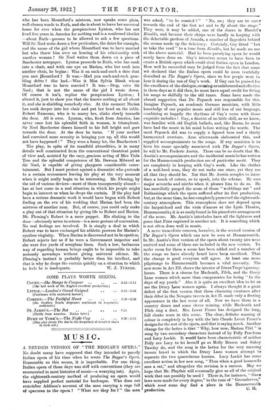MU SIC.
A REVISED VERSION OF " THE BEGGAR'S OPERA." No doubt many have supposed that Gay intended to parody Italian opera of his time when he wrote The Beggar's Opera. Reasonable as this seems, it is improbable. For one thing, Italian opera of those days was stiff with conventions (they are enumerated in most histories of music—a wearying list). Again, the eighteenth-century method of producing an opera would have supplied perfect material for burlesque. Who does not renieinber Addison's account of the man carrying a cage full of sparrows to the opera ? " What are they for ? " the man was asked, " to be roasted ? " " No, no ; they are to enter towards the end of the first act and to fly about the stage." They were, it may be added, one of the draws in Flanders Rinaldo, and because their chirps were hardly in keeping with the delectable gardens of Armida, a number of flageolets behind the scenes made up the deficiency. Certainly, Gay fitted " Let us take the road" to a tune from Rinaldo, but he made no use of the above material. Had he been parodying opera he would surely have done so. Gay's intention seems to have been to create a British opera which could rival Italian opera in London. How well he succeeded may be judged from the fact that some wit declared that the Italian opera could be more truthfully described as The Beggar's Opera, since so few people went to hear it during the run of Gay's work. If Gay can be praised for the excellence of the dialogue, seeming as unla,boured and effective in these days as it did then, he must have equal credit for fitting his songs so skilfully to the old tunes. Some have made the absurd suggestion that Dr. Pepusch was responsible for this. Imagine Pepusch, an academic German musician, with little knowledge of our popular music and still less of our language, combining so happily the rhythms of Gay's verse with those exquisite melodies ! Gay, a flautist of no little skill, as we know, was familiar with old English ballads, and, like Burns, he must have had the music in his mind before writing the words. The moat Pepusch did was to supply a figured bass and a thinly harmonized overture. Arne afterwards elaborated this, and supplied accompaniments to the songs. If any musician is to have his name specially associated with The Beggar's Opera, he will be Mr. Frederic Austin. There can be no doubt that Mr. Austin's accompaniments and the incidental music he has written for the Hammersmith production are of particular merit. They are completely in keeping with Gay's work. Like the clothes of a well-bred man, they do not make one stare, yet they are all that they should be. Net that Mr. Austin scruples to intro- duce a touch of colour, so to speak, into the scheme. He uses major sevenths and ninths when it pleases him to do so. Ho has mercifully purged the score of those " wobblings out " and Italianizings which the opera suffered after its first production, but, at the same time, he has completelypreserved the eighteenth- century atmosphere. This atmosphere does not depend upon the harpsichord and the viola d'amore at the Lyric Theatre, Hammersmith; it is as easily found in his pianoforte arrangement of the score. Mr. Austin's interludes have all the lightness and grace that Prior captured in another art. It is something which is not often done well in music.
A more immediate concern, however, is the revised version of The Beggar's Opera which can now be seen at Hammersmith. In Mr. Austin's first version of the opera about twenty airs were omitted and some of these are included in the new version. To make room for them a scene has been added and a number of the songs we have already heard have been sacrificed. That the change is good everyone will agree. At least one more pilgrimage to Hammersmith becomes a vital necessity. The new scene in Act III. shows the interior of Diana Tmpe's gaming. house. There is a chorus for Macheath, Filch, and the Drury Lane women which more than compensates for losing " In the days of my youth." Also it is quite an excellent idea to let us see the Drury Lane women again. I always thought it a great defect of the first version that those charming creatures after their debut in the Newgate tavern in Act II. made only a fleeting appearance in the last scene of all. Now we have them in a country dance and some clever miming, while Macheath and Filch sing a duet. Mrs. Lovat Fraser has designed the long, full cloaks worn in this scene. The clear, definite massing of colour is completely in key with the late Claude Lovat Fraser's designs for the rest of the opera, and that is saying much. Another change for the better is that " Why, how now, Madam Flirt " is sung by two secondary characters instead of by Polly Peachum and Lucy Lockit. It would have been characteristic of neither Polly nor Lucy to let herself go as Molly Brazen and Sukey Tawdry do, and the song is the better for the very amusing tavern brawl in which the Drury Lane women attempt to separate the two quarrelsome hussies. Lucy Lockit has some excellent action in her new song, " Thus when a good housewife sees a rat," and altogether the revision is a success. May we hope that Mr. Mayfair will eventually give us all of the original work that can possibly be used ? There is, for instance, " Since laws were made for every degree," to the tune of " Greenslecves," which must some day find a place in the Hammersmith


































 Previous page
Previous page